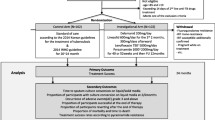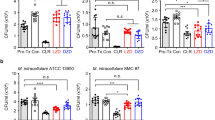Summary
In a randomized double-blind study, nine mycobacteremic patients with AIDS-related disseminatedMycobacterium avium complex (MAC) infection received clarithromycin or placebo in addition to a basic regimen that included isoniazid, ethambutol and clofazimine. All four patients receiving clarithromycin showed blood culture conversion and clinical response. Of the five patients treated without clarithromycin, two showed resolution of mycobacteremia and clinical reponse, while another two died without having shown response. The remaining patient deteriorated until a switch from placebo to clarithromycin led to blood culture conversion and rapid clinical improvement. After finishing six weeks of intensive treatment, clarithromycin was given in an open maintenance phase to all patients, initially in combination with rifabutin for 24 weeks and then alone. One patient had a relapse of MAC infection while receiving clarithromycin alone. The relapse was associated with acquired resistance to the drug. Clarithromycin appears to be a promising component of multi-drug therapy for patients with MAC infection. Monotherapy can lead to drug resistance.
Zusammenfassung
Neun AIDS-Patienten mit disseminierterMycobacterium avium complex (MAC)-Infektion wurden in einer randomisierten Doppelblind-Studie mit Clarithromycin oder Plazebo behandelt, die zu einer Basiskombination aus Isoniazid, Ethambutol und Clofazimine hinzugegeben wurden. Alle vier mit Clarithromycin behandelten Patienten sprachen auf die Therapie an. Von fünf ohne Clarithromycin behandelten Patienten sprachen zwei auf die Therapie an, während zwei andere ohne Therapieeffekt verstarben. Ein Patient verschlechterte sich kontinuierlich, bis der Austausch von Plazebo gegen Clarithromycin zur Blutkultur-Konversion und Rückbildung von Krankheitserscheinungen führte. Nach einer sechswöchigen Akuttherapie-Phase erhielten alle Patienten Clarithromycin in einer offenen Studie zur Rezidiv-Prophylaxe, zunächst in Kombination mit Rifabutin für 24 Wochen und anschließend als Monotherapie. Ein Patient hatte ein Rezidiv der MAC-Infektion, das in der Monotherapie-Phase auftrat und mit einer erworbenen Resistenz gegen das Medikament assoziiert war. Clarithromycin ist eine vielversprechende Substanz für ein Kombinationsregime zur Behandlung der MAC-Infektion. Eine Monotherapie kann zur Resistenz-Entwicklung führen.
Similar content being viewed by others

References
Ellner, J. J., Goldberger, M. J., Parenti, D. M. Mycobacterium avium infection and AIDS: a therapeutic dilemma in rapid evolution. J. Infect. Dis. 163 (1991) 1326–1335.
Horsburgh, C. R. Mycobacterium avium complex infection in the acquired immunodeficiency syndrome. N. Engl. J. Med. 324 (1991) 1332–1338.
Hawkins, C. C., Gold, J. W. M., Whimbey, E., Kiehn, T. E., Brannon, P., Cammarata, R., Brown, A. E., Armstrong, D. Mycobacterium avium complex infections in patients with the acquired immunodeficiency syndrome. Ann. Intern. Med. 105 (1986) 184–188.
Macher, A. M., Kovacs, J. A., Gill, V., Roberts, G. D., Ames, J., Park, C. H., Straus, S., Lane, H. C., Parrillo, J. E., Fauci, A. S., Masur, H. Bacteremia due toMycobacterium avium-intracellulare in the acquired immunodeficiency syndrome. Ann. Intern. Med. 99 (1983) 782–785.
Young, L. S. Mycobacterium avium complex infection. J. Infect. Dis. 5 (1988) 863–867.
Hoy, J., Mijch, A., Sandland, M., Grayson, G., Lucas, R., Dwyer, B. Quadruple-drug therapy forMycobacterium avium-intracellulare bacteremia in AIDS patients. J. Infect. Dis. 161 (1990) 801–805.
Masur, H., Tuazon, C., Gill, V., Grimes, G., Barid, B., Fauci, A. S., Lane, H. C. Effect of combined clofazimine and ansamycin therapy onMycobacterium avium-Mycobacterium intracellulare bacteremia in patients with AIDS. J. Infect. Dis. 155 (1987) 127–129.
Agins, B. D., Berman, D. S., Spicehandler, D., Elsadr, W., Simberkoff, M. S., Rahal, J. J. Effect of combined therapy with ansamycin, clofazimine, ethambutol, and isoniazid forMycobacterium avium infection in patients with AIDS. J. Infect. Dis. 159 (1989) 784–787.
Dautzenberg, B., Truffot, C., Legris, S., Mehoyas, M. C., Berlie, H. C., Mercat, A., Chevret, S., Grosset, J. Activity of clarithromycin againstMycobacterium avium infection in AIDS patients: a controlled clinical trial. Am. Rev. Respir. Dis. 144 (1991) 564–569.
Chiu, J., Nussbaum, J., Bozzette, S., Tilles, J. G., Young, L. S., Leedom, J., Heseltine, P. N. R., McCutchan, A., andthe California Collaborative Treatment Group Treatment of disseminatedMycobacterium avium complex infection in AIDS with amikacin, ethambutol, rifampin, and ciprofloxacin. Ann. Intern. Med. 113 (1990) 358–361.
Naik, S., Ruck, R. In vitro activities of several new macrolide antibiotics againstMycobacterium avium complex. Antimicrob. Agents Chemother. 33 (1989) 1614–1616.
Fernandes, P. B., Hardy, D. J., McDaniel, D., Hanson, C. W., Swanson, R. N. In vitro andin vivo activities of clarithromycin againstMycobacterium avium. Antimicrob. Agents Chemother. 33 (1989) 1531–1534.
Anderson, R., Joone, G., Van Rensburg, C. E. J. Anin vitro evaluation of the cellular uptake of and intraphagocytic bioactivity of clarithromycin (A 56268, TE-301), a new macrolide antimicrobial agent. J. Antimicrob. Chemother. 22 (1988) 923–933.
Baron, E. J., Young, L. S. Amikacin, ethambutol, and rifampin for treatment of disseminatedMycobacterium avium-intracellulare infections in patients with acquired immune deficiency syndrome. Diagn. Microbiol. Infect. Dis. 5 (1986) 215–220.
Kent, P. T., Kubica, G. P.: Public health mycobacteriology: a guide for the level III laboratory. U. S. Department of Health and Human Services, Public Health Service, Centers for Disease Control, Atlanta 1985.
Schröder, K. H. Nährbodenrezepte zur Kultur von Tuberkulosebakterien. In:Deutsches Zentralkomitee zur Bekämpfung der Tuberkulose (eds.): Expertisen: Die Bakteriologie der Tuberkulose. Deutsches Zentralkomitee zur Bekämpfung der Tuberkulose, Hamburg 1985, pp. 35–44.
Canetti, G., Fox, W., Khomenko, A., Mahler, H., Menon, N. K., Mitchison, D. A., Rist, N., Smeley, N. A. Advances in techniques of testing mycobacteria drug sensitivity and the use of sensitivity tests in tuberculosis control programmes. Bull. World Health Organ. 41 (1969) 21–43.
Shepard, C. C. Chemotherapy of leprosy. Ann. Rev. Pharmacol. 9 (1969) 37–50.
Heifets, L. B., Iseman, M. D., Lindholm-Levy, P. J., Kanes, W. Determinations of ansamycin MICs forMycobacterium avium complex in liquid medium and by radiometric and conventional methods. Antimicrob. Agents Chemother. 28 (1985) 570–575.
Ruf, B., Schürmann, D., Mauch, H. Acquired resistance of MAI to clarithromycin. Am. Rev. Respir. Dis. 145 (1992) 1241–1242.
Yaiko, D. M., Nassos, P. S., Hadley, K. Therapeutic implications of inhibition versus killing ofMycobacterium avium complex by antimicrobial agents. Antimicrob. Agents Chemother. 31 (1987) 117–120.
Heifets, L. B., Lindholm-Levy, P. J., Comstock, R. D. Clarithromycin minimal inhibitory and bactericidal concentrations againstMycobacterium avium. Am. Rev. Respir. Dis. 145 (1992) 856–858.
Staib, F., Seibold, M. Mycological-diagnostic assessment of the efficacy of amphotericin B + flucytosine to controlCryptococcus neoformans in AIDS patients. Mycoses 31 (1988) 175–186.
Neu, H. C. The development of macrolides: clarithromycin in perspective. J. Antimicrob. Chemother. 27 (1991) (Suppl. A) 1–9.
O'Neill, S. J., Millar, E. D., Coles, S. J., Bachand, R. T. Safety and efficacy of clarithromycin in the treatment of acute and mild to moderate respiratory tract infections. Ir. Med. J. 84 (1991) 33–35.
Author information
Authors and Affiliations
Rights and permissions
About this article
Cite this article
Ruf, B., Schürmann, D., Pohle, H.D. et al. Effectiveness of the macrolide clarithromycin in the treatment ofMycobacterium avium complex infection in HIV-infected patients. Infection 20, 267–272 (1992). https://doi.org/10.1007/BF01710792
Received:
Accepted:
Issue Date:
DOI: https://doi.org/10.1007/BF01710792



